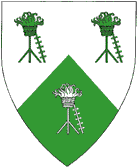|
|

Newsletter of the College of Heralds of An Tir
Volume 3, Number 2 ~ July 30, 2004
Long live King Thorin and
Queen Dagmaer!
|
|
Table of Contents:
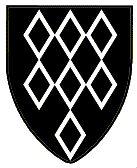
So, what do you want to see in The Heralds' Page? More about field? Court? Reports? Cartoons? Articles on what? I get some feedback, but really, not enough. I flat refuse to believe that I'm so perfect an editor the Heralds' Page meets everyone's needs and expectations. But I hear little from the readership, although I know full well that with the web archive there are readers from all over the SCA, not just An Tir.
Anyone can offer suggestions and anyone can contribute. I've received some lovely articles from a gentle in Atlantia who had published them originally in a local newsletter and has graciously permitted republishing here. Have you written heraldic articles for your branch newsletter? Reprinting them here will allow other heralds to share their issue of the Heralds' Page, or direct clients to the online archive, so basic how-to heraldry for the non-herald articles have as much place here as do the ponderous treatises on conflict and style I tend to churn out.
This is a forum, your forum. How may we serve you?
Teceangl Bach
Ounce Herald
Heralds' Page editor
Ursula Georges, alias Ursula Whitcher
What is an impresa?
Definition
The impresa is a late medieval and Renaissance art form. "Impresa" is an Italian word which means "device"; but though imprese can be superficially similar to heraldic devices, there are several important differences.
What exactly is an impresa? In 1605, William Camden gave this definition:
An imprese, as the Italians call it, is a device in picture with his Motte, or Word, born by noble or learned personages, to notifie some particular conceit of their owne . . . . As for example: Wheras Cosimi Medici Duke of Florence had in the ascendent at his nativitie the signe Capricorne, under which also Augustus and Charles the fifth, two great and good Princes were borne: he used the celestial signe Capricorne, with this Motte; FIDEM FATI FORTUNA SEQUEMUR, for his Imprese, particularly concerning his good hope to prove like unto them . . . .
There is required in an Imprese (that we may reduce them to few heades) a correspondence of the picture, which is as the body, and the Motte, which as the soul giveth it life. That is, the body must be of fair representation, and the word in some different language, wittie, short, and answerable thereunto neither too obscure nor too plaine, and most commended, when it is an Hemistich, or parcell of a verse.
In other words, an impresa is a combination of a picture (body) and motto (soul). It's used for individual self-expression, the picture should be fair, and the motto should be witty and in a foreign language.
The individual nature of an impresa is particularly important. One person might use many different imprese to express different ideas and moods, or to commemorate different occasions.
How imprese were used
Imprese first appeared in the French and Burgundian courts in the late fourteenth century. They rapidly became popular among European nobility: for a time, displays of imprese seemed to outnumber displays of heraldry. Imprese were embroidered on clothing, displayed at tournaments, painted in portraits, described in literature, and even carved into wooden ceilings. A discussion of some of the most common uses follows.
Tournaments
Imprese were an important part of the lavish pageantry of late medieval and Renaissance tournaments. Special shields were carved and painted with the imprese pictures, and knights often dressed themselves and their entourages to match an impresa's theme. From the time of Queen Elizabeth's reign onwards, a participant in an English tournament was required to compose an impresa. Before the tournament, the knight's page presented the impresa to the Queen (or later to King James). The impresa was usually accompanied by an explanatory song or poem.
One fifteenth-century Flemish impresa shield showed a man standing between a Grim Reaper-like figure and a maiden. The motto was "Vous ou la mort," or "You or Death."
A pageant shield by Antonio Pollaiuolo from the 1470s shows the mythical athlete Milos of Croton. The athlete's body is molded in gesso and then gilded. A motto is painted around the edge of the shield.
Inigo Jones designed the settings for Prince Henry's Barriers at Whitehall in 1610. One of Jones' costume designs, which may be for this event, shows knight dressed à l'antique and carrying an impresa shield. The tiny shield is obviously designed for display, not for combat.
Portraits
Knights often commemorated their participation in tournaments by commissioning portraits. Such portraits often included imprese; the impresa picture might be incorporated in the sitter's pose, or inset as its own design.
One such painting is a miniature by Nicholas Hilliard which shows George Clifford, Earl of Cumberland, in tournament armour. Behind him is a stormy sky. The motto "Fulmen aquasque fero," "I bear lightning and waters," which is painted along the rim of the miniature.
A full-length portrait of Sir Edward Hoby, painted by an unknown artist in 1583, includes insets of both his arms and an impresa. In the impresa, a lady stands before a castle; in the foreground is a pile of cast-aside armour. The lady holds a twisting scroll with the motto "Reconduntur non retunduntur," "Laid aside, not blunted."
Impresa portraits weren't limited to knights; one portrait of Queen Elizabeth shows her holding a rainbow. The motto "Non sine sole iris," "No rainbow without the sun," is inscribed above the rainbow.
Embroidery
Embroidered imprese appeared on bedcovers, clothing, tapestries, and more.
Mary Queen of Scots embroidered some particularly memorable imprese, which, as well as being beautiful, expressed her political goals. One showed a tortoise climbing a crowned palm tree, with the motto "Dat Gloria Vires," or "Glory Gives Strength." The tortoise represented her ambitious husband Darnell.
Published collections
Books about imprese, such as Paolo Giovio's Dialogo dell'Imprese Militari et Amorose, first published in Rome in 1555, fed the art form's popularity and encouraged its spread.
Imprese appeared in other sorts of books as well. One Elizabethan book about tournaments includes a drawing of jousters in which the men's imprese appear above their horses. Most of the imprese in the manuscript are taken from Giovio's book. Imprese also appeared in emblem books. (Emblems are similar to imprese, but discuss general moral truths, and do not belong to a particular person. Henry Peacham's book Minerva Britannica, published in 1612, included a woodcut and poem based on one of the Earl of Essex's imprese, which may have been used in a tournament in 1586 or 1590.
How can I make my own?
A Renaissance set of rules
In the illustrated edition of his Dialogo dell'imprese, published in 1559, Paolo Giovio set forth the following six rules for an impresa. (I follow Alan Young's translation.)
- There should be a proper proportion between soul and body [motto and picture].
- The impresa should be neither so obscure that the Sibyl must interpret it, nor so obvious that every plebeian can understand it.
- It should have a beautiful appearance, making use of stars, the sun, the moon, fire, water, green trees, mechanical instruments, strange animals, and fantastic birds.
- It should contain no human form.
- It should have a motto, which is the soul of the body, and should be expressed in a language other than the native language of the bearer, so that the meaning may be more obscure.
- The motto should be brief, but not so much that it creates uncertainty. Two or three words may be enough, unless they are in the form of verse.
These rules weren't always followed -- several of the imprese mentioned above contain human figures, for instance, and the motto wasn't always in a foreign language -- but they're a good start for your invention!
Other ways to create a motto
Composing an impresa could be intellectually taxing, and not everybody who wanted or needed to display one felt up to the work. Here are some authentic ways to choose mottoes and find design ideas without a vast classical education.
Hire a poet.
One of the simplest ways to find a good impresa was to pay someone else to do it.
- In 1613, the Earl of Rutland paid Shakespeare 44 gold shillings to compose an impresa.
- Ben Jonson wrote speeches for the Rich brothers to use in the presentation of their imprese; he probably composed the imprese, as well. (However, Jonson also wrote a satirical poem about knights who couldn't create their own imprese!)
The writer of this article is quite willing to follow in such illustrious footsteps.
Choose one from a published list.
- The knights in the Elizabethan manuscript on tournaments mentioned above are shown using mottoes taken from Giovio's Dialogo.
Alan Young's book The English Tournament Imprese contains an exhaustive list of tournament mottoes from Tudor and Jacobean England. Emblem books provide a convenient source: the mottoes used in Renaissance emblems were often similar to (or borrowed from) imprese mottoes, and collections such as Alciato's Book of Emblems may be found online.
Borrow from the classics.
Imprese often quoted famous texts such as the Bible and the works of the Latin writers Ovid and Vergil. An impresa might allude to a particular story, or create a complicated joke by leaving out certain words.
- One Elizabethan impresa quoted Vergil's Eclogues: "Iam redit et virgo," "Now the virgin returns," in a compliment to the Queen.
- Another impresa quoted the Aeneid, "Aut spoliis laetemur opimis," "Either let us rejoice in rich spoils . . ." while omitting the second half of the quotation (or enjoy a glorious death.)
- In his 1605 book Remaines . . . concerning Britain William Camden quotes an imprese with the motto "Amor est medicabilis herbis," "Love can be cured by herbs," which refers to Ovid's Epistulae. Ovid's text states that herbs and potions cannot cure love.
- In 1610, Lord Compton bore the tournament device "Nisi dominus," "Unless the Lord . . ." This refers to Psalm 127:1: "Except the Lord build the house, they labor in vain to build it."
Online sources such as the Perseus Project include both Latin texts and English translations; by comparing the two versions, even someone with little knowledge of Latin could choose an appropriate motto from Vergil, Ovid, or the Vulgate.
Selected Imprese Mottoes
The following list of sample mottoes is taken from Alan Young's extensive collection, The English Tournament Imprese.
- My sufferan remedy (English, My sovereign remedy) 1614.
- In te e la nostra speranza (Italian, Our hope is in you) 1610.
- Dum placeo pereo (Latin, While I please, I perish) 1614.
- Serviet aeternum dulcis quem torquet Eliza (Latin, He whom sweet Eliza tortures will serve eternally) 1582.
- Aut solve aut scinde (Latin, Either loose or cut!) 1610.
- Tempestas (Latin, Storm) 1610.
- Tu mihi principium numeri (Latin, You are the beginning of numbers to me) 1610.
- Sans remedy (French, Without remedy) 1522.
- Tremet et ardet (Latin, He trembles and burns) 1595.
- In prison I am at libertie, and at libertie I am in prison (English, In prison I am at liberty, and at liberty I am in prison) 1522.
- Loialte/ Bi pen, pain nor treasure, truth shall not be violated (English, Loyalty, by pen, pain, nor treasure, truth shall not be violated) 1527.
Bibliography and Suggested Sources
General Imprese Information
- Alan Young, The English Tournament Imprese, New York: AMS Press, Inc., 1988
- Alan Young, Tudor and Jacobean Tournaments, London: George Philip, 1987
- Michel Pastoureau, Traité d'Héraldique, 2nd ed., Paris: Grands Manuels Picard, 1993
- François Velde, "Imprese," http://www.heraldica.org/topics/imprese.htm, 2000
- William Camden, Remaines of a greater worke, concerning Britaine, the inhabitants thereof, their languages, names, surnames, empreses, wise speeches, poësies, and epitaphes, 1605, Early English Books Online, http://eebo.chadwyck.com/home/
- My webpage, http://www.doomchicken.net/~ursula/sca/
Other Motto Sources
Images
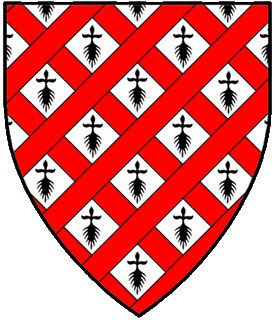
by Iago ab Adam, OL, JdL

From 'Two Anglo-Norman Culinary Collections Edited from British Library Manuscripts Additional 32085 and Royal 12.C.xii' Speculum 61/4 (1986) pp. 859-882, by Constance B. Hieatt and Robin F. Jones.
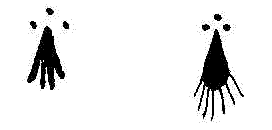 Ermynee. Serra fet blanc e bien savoree de bon poudre de gyngyvre, e de quibebes e de clous, e cele viaunde deit estre partie ou vert desirree.
Ermynee. Serra fet blanc e bien savoree de bon poudre de gyngyvre, e de quibebes e de clous, e cele viaunde deit estre partie ou vert desirree.
 Vert desirree. Let d'alemaundes, flur de rys, braoun de chapoun, vyn vermail, sucre, percil; le colour serra vert.
Vert desirree. Let d'alemaundes, flur de rys, braoun de chapoun, vyn vermail, sucre, percil; le colour serra vert.
Translation:
Ermynee (spiced white pottage). The dish should be white and well flavored with good ground ginger, and with cubebs and cloves, and should be combined (in strips of alternating color) with "vert desirree."
(Editors Note: The ingredients for the dish are not given fully, but probably resembled those of "Vert desir(r)ee," with which it was to be served.)
Vert Desirree (Green Syrian food). Almond milk, rice flour, capon meat. Red wine, sugar, parsley; the colour should be green; (the ingredients are to be boiled in a clean pot and then put (to cool and presumably set) in a dust-free place, in the vessel in which they are cooked: pomegranate (seeds) set on top.) (cooking instructions from the recipe previous in the collection- 'Blanc desirree')
Lady Marya Kargashina
lions-blood@antir.sca.org |
July 30, 2004
Send thy comments here: | Jessica Smith-Carlock
5114 SE Holgate
Portland, OR 97206
503-772-0002
|
Commentary on this Letter will be due September 10th, 2004.
(Send comments to Lions Blood Herald, information at top of this page)
The August Lions Blood meeting will be held on Sunday, August 15th, 1pm, at the home of Christopher Queue Forchee: 7757 40th Ave. NE, Seattle, WA 98115. The house is in the Wedgwood area, East of Ravenna, North of UW.
Directions:
By Bus: Bus route 71 stops at the end of my driveway, tell the driver you want to get off at 80th St. Bus route 65 stops on NE 80th St & 35th Ave NE, walk 5 blocks east on 80th.
By Car: ** IMPORTANT PARKING NOTE **
The curb in front of my house, and the space directly across the street from it is a bus stop. Don't park there, even though the paint is faded. Easiest parking is on NE 80th St., on the side of the house.
From the South I-5 *Express Lanes*: Take the Lake City Way exit (it's a left-ramp off the freeway). Get into the Right lane of the ramp as soon as possible after exiting the freeway. Turn Right at the first light (NE 80th St). Note: NE 80th does not go through to my house, there's stuff in the way, so... Turn Right at the first 4-way stop (20th Ave NE.). Turn Left at the first light (NE 75th St). Follow the "From NE 75th St" directions, below.
From the South via I-5 (incl. 520 & 90): Take I-5 to exit 171 (522, Bothell). Stay to the right hand of the ramp. Just as the ramp goes around a bend there will be an exit to your Right. Take it. Merge into 73rd heading East (only option). Stop at the stop, stay on 73rd. Turn Left at the next stop sign, onto 12th, heading North again. Turn Right at the light, onto NE 75th St., heading East again. Follow the "From NE 75th St" directions, below.
From the North via I-5: Take the exit for 80th St. & 85th St. Follow the signs for 80th St. East Bound, turning left at the end of the ramp. You will cross over I-5. Continue on 80th St. for a while. Turn Right (south) @ the 4-way stop on 20th
Turn Left (east) @ the first light (NE 75th St.). Follow the "From NE 75th St" directions, below.
From NE 75th St: Turn Left at the 4-way stop (onto 40th Ave NE). Go two short "blocks." The house will be on your Left just as the school yard ends, on the corner with NE 80th St. If you completely pass the school yard, or cross over 80th St., you've gone too far.
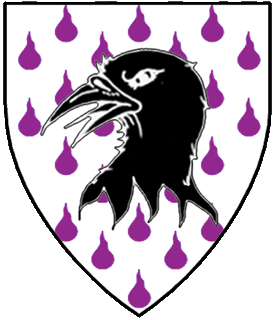
Greetings from Lions Blood.
A reminder from the Administrative Handbook, section IV.C.2.:
Documentation - Documenting evidence must be included for any non-standard name or armorial items or practices. Whenever possible, such documentation should include photocopies of appropriate sources and references to specific pages in source material.
This includes order names and household names, not just personal names. The commenters will help support submissions, but the submitter is ultimately responsible for providing documentation. As submitters are rarely heralds, what should occur is that the submitter's herald provides needed documentation. The An Tir Heralds email list is a great resource for locating documentation, as are the other online heraldry lists. Æstel Herald will provide needed documentation, and many other heralds in this kingdom are willing to help submitters or heralds. Black Lion and Lions Blood both will be glad to help heralds find the assistance they need for name documentation. Returns for lack of documentation are largely preventable; please help in any way you can.
МАРЫА
КАРГАШИНА (Marya)
From Wreath: A Cautionary Word Regarding "Conflict Tables"
It has come to our attention that there is a growing trend in the College to create "conflict tables". These tables summarize precedent on some class of armorial elements, such as crosses, flowers, or lines of division. The tables use a simple format that allows one to (for example) compare two types of crosses and look up whether they have no difference, a single CD ("significant" difference), or X.2 difference ("substantial" difference.) The tables also allow the user to identify the LoARs in which the rulings referenced by the table were made.
We understand the desire to provide a quick and simple summary of conflict issues, and we thank the compilers of these tables for their hard work. However, we caution the College that these tables may inadvertently contribute to an inaccurate view of the heraldic issues. We have reached this conclusion by investigating the source of some assertions made in College of Arms commentary, which turned out to be based on overgeneralizations from conflict tables, rather than being based on the combination of the Rules for Submission, examples of period armory, and precedents (past rulings in LoARs). We are happy to see that the conflict tables of which we are aware do reference an LoAR for each assertion made in the table. We suggest that people make use of the conflict tables, but that they do not make up their minds about conflict issues until they have read the full LoAR ruling referenced by the table, and until they have read the LoAR rulings referenced in closely related areas of the table.
In many cases, if there is not a clear general ruling pertaining to some class of armorial elements, it is because the issues pertaining to that class of elements are not easily summarized. RfS X, "Conflicting Armory", explains how armorial conflict in the SCA is based on an attempt to emulate period armorial practices:
A piece of armory may not be too similar to other pieces of armory, as is required by General Principle 3a of these rules. Period armory frequently distinguished between immediate relatives, like a father and his son, by making a single change to the arms in a process called "cadency". The changes made in such circumstances can be considered the smallest change that period heralds would recognize. This section defines ways in which submitted armory must be changed to be sufficiently different from protected armory.
It is just as easy - or as difficult - to create a table summarizing the grammar of a language, as it is to create a table summarizing period armorial practices for difference. In both natural language and in armory, there are many generally applicable rules, but also a large number of specific exceptions.
We would like to address one specific misconception which, according to some commenters, derived from an overgeneralization of a conflict table. One conflict table concerning crosses had a category of "cross throughout" (with sub-categories for the particular types of cross throughout, such as equal-armed Celtic quarter-pierced.) As a result of the cursory scan of this category, which generally gave a CD between the "throughout" cross and the cross with which it was compared, more than one College of Arms member incorrectly generalized that all crosses throughout were a CD from all crosses which were not throughout. The precedents listed in the LoAR table explicitly denied that generalization, but one had to look at the cited precedents to see that information. One example of a precedent referenced by the conflict table that denied this generalization:
[A Celtic cross vs. a Celtic cross equal-armed, quarterly pierced and throughout] There is no heraldic difference for the charge being throughout, or not. However, there's a CD ... for the quarter-piercing, which is visually equivalent to adding a tertiary delf. (Toirrdelbach Ua Mel Doraid, October, 1992, pg. 16)
A relatively recent LoAR also addressed this issue. Clarifying comments have been inserted into the quote in square brackets:
While we give a CD for a standard cross throughout [the ordinary] versus a cross couped, for most crosses (such as crosses fleury) we do not give such difference for couped [not-throughout] versus throughout. (LoAR February 2002).
From Wreath: Raw Numbers
Granted, Laurel performs a different sort of service for our clients than Lord Lyon King of Arms of Scotland performs for his clients. Our College of Arms is organized differently from (and is much larger than) Lyon's Court. And we don't have to do any genealogy. But Electrum suggested that the following information about the Lyon Office workload might be of interest to our College, and we concur. This information is from an article by Anthony Maxwell in the April 2004 edition (number 24) of Tak Tent, the newsletter of the Heraldry Society of Scotland:
In what is possibly a first, the Court of the Lord Lyon has issued some figures giving the number of grants and matriculations made in 2003. There were 78 new grants of arms, of which 55 were to individuals, 14 to corporate bodies, and 9 to local authorities. There were, in addition, 43 matriculations from existing grants. This is a total of 121 new arms in the year. I understand this is not the highest number in a single year but well up on an average year and I am informed that 2004 is set to be something of a bumper year. The number of new arms for this year is likely [to] be over 130 and possibly as many as 150 which may be somewhere very close to the maximum capacity of the Court as it is currently organized. The level of service from the Court is still excellent but with heraldry becoming ever more popular and the increasing number of petitions arriving on Lyon Clerk's desk, one wonders what will be the Court's next move to ensure the smooth flow of arms from this ancient and most respected Office.
By contrast, while we do not have figures for Laurel's workload in 2003, we did publish the figures for 2002 for the Laurel office in the Cover Letter for the February 2003 Letter of Intent: 3797 items, with items defined as "acceptances, returns, transfers, and administrative items (reblazons, protected items, and such), whether paid or unpaid... [omitting] pended items." Siren also observes, regarding Lyon's workload, that "We do more than that at Pennsic. And I'm only counting devices."
From Wreath: Carpe Ovum Diabolicum
It's been an interesting almost-three years. Thanks to the College of Arms and to the heraldic submitters of the SCA for raising so many intriguing questions concerning period heraldry. Thanks to François and the SCA Board of Directors for providing me with the incentive/mandate to deeply consider these questions, rather than spending my time in somewhat less dry pursuits.
To Laurel, to Pelican, and to the Atlas on whose shoulders all the sovereigns rested, Laurel Clerk: it was great working with you guys! Likewise to the stalwart Wreath staff, without whose labors, support, and last-minute research, the armory side of the submissions process would have been sorely diminished. Heartfelt thanks to David Electrum, Juliana Siren, Christopher Queue Forchée, Francesca Æstel, Elisabeth Pomegranate, Rafaella Blue Anchor, Teceangl Ounce, Richenda Boar, Ciaran Goutte de Sang, Bruce Oak Leaf, Sebastian Sterne, and Rouland Carre.
And lastly, thanks to the chickens who provided the three dozen eggs per month, which (after appropriate deviling) kept the Wreath meetings going, and engendered the unofficial Wreath team motto that heads this section of the LoAR. Yes, we know that stuffed eggs mixed with hot savory spices (like mustard) probably don't predate the end of our period (even though there are precursors at least as early as Apicius) and that the word "deviled" for this sort of cooking treatment for eggs or meats doesn't date until well past period. And we may not have formed the Latin correctly. We didn't care. After all, at least in the organization of this Laurel's tenure, "that's a Pelican problem."
From Laurel: Thank You
It takes a lot of work by hundreds of people at every level to support heraldry throughout the Known World. I wish to say: to the dedicated field heralds, who spend hours in the hot sun or the cold wet wind, calling the pairings with pomp and dignity; to the court herald, whose vocal skills make what is happening "in the presence" known to even the back row; to the consulting heralds, giving countless hours of their own time helping to explain the subtle workings of onamastics or armorial design; to the heralds working on submissions, spending long evenings with word processors, forms, and markers to get the names and armory of our friends into and through the registration process; to the principal heralds, who have the responsibility of making sure that all of the various duties are accomplished as well as being counselors, mentors, and advisors; and to the College of Arms, the hours of research, conflict checking and commentary given to aid in the registration of names and armory, I give you honour and my sincere and heartfelt thanks. It has been my honour to be at the head of such a host. Your passion, enthusiasm and dedication is awe-inspiring. Thank you for your efforts and time.
The everyday operation of the Laurel office is very much a team effort. Without the help and advice from the Laurel staff, the amount of work could be overwhelming. Many of the support tasks are quietly and efficiently managed by people who do the work not for recognition but because it needs doing. I bring them to your attention in the hopes that you will help me thank them. The Laurel Web page would not have the fullness of information it does without the efforts of Jaelle of Armida and her minions. The printing and mailing of the LoAR, often with impossibly short deadlines, has been handled by Symond Bayard le Gris. Updating the database for the Ordinary and Armorial and the creation of the updates is a never ending and thankless task so ably accomplished by Herveus d'Ormonde. The challenging task of distilling the precedent-setting rulings from our decisions into a useful and informative document is being accomplished with skill and finesse by Jeanne Marie Lacroix. There are many people that work so hard to keep this office running that I can only beg your pardon and forgiveness if I have not specifically included you in this list.
And finally, there are three people without whom this tenure would not have been possible. These three have been my support, my deputies, my teachers, and my friends. Zenobia Naphtali as Wreath has put forth a fantastic effort. Besides the sheer volume of submissions to rule and write decisions on, she often put up with my heretical ideas and then with an open mind discussed the whys and hows until a workable solution was found (or not). I found her wisdom and experience an invaluable resource. Mari Elspeth nic Bryan as Pelican has set a standard for the explanation of decisions that will be hard to maintain. It takes time to write such complete discussions and I hope that the College and the submitters appreciate the value. I admire her passion for making sure that the person submitting the name was treated fairly and consistently by the rules. Daniel de Lincoln as our Clerk has been a tremendous resource and support. Daniel spent many many hours with the programs and applications used in the processing the LoIs and the LoARs. Without his constant vigilance we might have violated the "secret laurel style guide", resulting in mayhem in the LoAR.
In the July 1981 cover letter Wilhelm Laurel added the rank of Herald Extraordinary, saying the following.
This rank is reserved for those heralds who have greatly served the College of Heralds and/or the College of Arms and have achieved the highest level of competence in heraldry.
and he further stated
The rank of Herald Extraordinary shall be permanent so long as the holder continues to remain active in SCA heraldry. ... Each Herald Extraordinary shall have a title that is his/her own personal title that s/he shall hold so long as s/he remains active. If s/he should retire from the SCA, the title shall retire with her/him and shall not be used again by anyone else.
The awarding of rank and a personal heraldic title is for much more than simply completing a term in office. Daniel, Mari, and Zenobia have each actively served at every level of heraldry, giving much of themselves for many years. The knowledge that they have and share shows them to have the highest level of competence. In recognition of years of service, I hereby award unto Mari, Zenobia, and Daniel, the rank of Herald Extraordinary. Each may at her or his choice submit a personal heraldic title to be registered for their use. These are not "retirement" titles but a reward for the many years of service. I will note that each has already committed to continue working either within the College of Arms or in the local kingdoms' Colleges of Heralds.
It is with equal measures of sadness and relief that I turn the office of Laurel Sovereign of Arms over to Shauna. The years have been filled with challenges, learning and a lot of work. But, I have worked with some of the most intelligent and dedicated people in the Society. It has been an incredible experience. And I will miss it.
An Tir results from the March 2004 LoAR (see the LoAR for full text):
(typos might exist - only the LoAR itself is definitive - due to the plethora of explanations, full LoAR text has been included)
REGISTERED
- Aine Paixdecoeur. Name and device. Or, a sperm whale naiant to sinister base sable between two bendlets wavy all between two roses vert seeded or.
- Alan Fletcher. Badge. Argent, two arrows in chevron sable.
Please advise the submitter to draw the heads of the arrows more boldly.
- Alan Fletcher. Badge. Sable, two arrows in chevron argent.
Please advise the submitter to draw the heads of the arrows more boldly.
- Alexander Kirkpatrick. Name and device. Azure estencely argent, a wolf rampant Or.
Listed on the LoI as Alastair Kirkpatrick, this name was submitted as Alastar Kirckpatrick and changed to follow documented spellings. The submitter requested authenticity for 1300-1500 Scottish and allowed any changes.
The submitted form of this name was Scots, a language closely related to English. (The form Alastair, used by Kingdom, is a Gaelic rather than Scots form.) All information found by the College showed that forms similar to Alastar only appeared in Scots in the second half of the 16th C. Dated Scots forms of this name that were found by the College include Allester, 1581 (Black s.n. MacEwan), Alester Modrell, 1596 (Black s.n. Motherwell), and Alister McWilliam McPhadrik, 1579 (Black s.n. MacKay). Additionally, Effric Neyn Ken{gh}ocht Mcherrald found examples of this name in her research:
- 16th century (Inverness Records):
- Allister Dow in Abertarff 1562
- Allister Roy Mcken3ie 1562
During the submitter's desired time period, the form of this name in use in Scots was Alexander. For example, Black, s.n. Tod, dates Alexander Tode to 1467. As no evidence was found of any form of Alastar in use in Scots previous to the second half of the 16th C, we have changed the given name to Alexander in order to meet the submitter's request for authenticity.
He has permission to conflict with a badge of Liriel Correll of Tuatha Keep, Azure, mulletty, a fox salient Or.
- Berik of Wealdsmere. Holding name and device (see RETURNS for name). Per pale sable and gules, a pale embattled counter-embattled between two pawprints Or.
Submitted under the name Berik of Sugdak.
- Bran mac Conchobair. Device. Argent, a bend sinister cotised azure between two ravens sable.
- Catarine Quhiting. Name and badge. Vert vêtu, a needle fesswise argent.
Submitted as Katherine Quhiting, the submitter requested authenticity for 14th C Scottish and allowed minor changes. Talan Gywnek's article "A List of Feminine Personal Names Found in Scottish Records" dates the form Catarine to 1360. We have changed the given name to this form in order to meet the submitter's request for authenticity.
- Cyneburh of Hartwood. Name and device. Per chevron sable and Or, a thistle counterchanged Or and vert.
- Danescombe, Shire of. Device. Per chevron argent and Or, a yale rampant contourny and in base a laurel wreath gules.
- Dun an Chalaidh, Shire of. Device. Per chevron azure and vert, a chevron embattled between two laurel wreaths and a lighthouse argent enflamed gules.
- Durant Ramberti. Name and device. Purpure, a phoenix and in chief a chalice all within a bordure rayonny argent.
Listed on the LoI as Durante Ramberti, this name was submitted as Durant Ramberti Caiaphas. The LoI explained the issues with the element Caiaphas:
[T]he submitter's documentation for Caiaphas, and the total of what the CoH were able to locate, all indicated that the name belonged to a single Biblical figure before the time of Christ. As this name element could not be found to be combinable with an otherwise post 1300 Italian name, the element was dropped at kingdom.
The spelling of the given name was also changed to match the documentation.
While Durante is a period Italian masculine given name, Siren found evidence for the form Durant in French:
R&W (s.n. Durrand) dates [Durant stabularius] to t. Henry II and Morlet Picardie dates [Henricus Durant]. The combination is registerable with a weirdness for combining either English and Italian or French and Italian.
As the submitter did not request authenticity for a language, we have returned the given name to the form Durant based on the documentation found by Siren.
- Elisabeth Piper. Device change. Or, a unicorn couchant contourny purpure.
Her previous device, Or, a unicorn counter-couchant purpure, overall a recorder palewise proper, is released.
- Emma La Blanche. Name and device. Quarterly vert and argent, a cross purpure and overall a sun in splendor Or.
Submitted as Emma Le Blanc, the submitter requested that her name be made authentic for a Norman woman. She also said that she cared about the meaning 'the white'.
The LoI documented the byname from Cateline de la Mor's article "Sixteenth Century Norman Names" (http://www.s-gabriel.org/names/cateline/norman16.html). However, this article gives forms found in a history book; we do not know the actual forms the names took in period.
Marie-Thérèse Morlet, in Étude d'Anthroponymie Picarde, dates the masculine le Blanc and feminine la Blanche to 1363 and 1404 respectively. The form La Blanche is found in 1421 in Paris, in Aryanhwy merch Catmael's article "French Names from Paris, 1421, 1423, & 1438" (http://www.ellipsis.cx/~liana/names/paris1423.html). As the submitter requested a byname meaning 'the white', we have changed to to the feminine form La Blanche to make this byname have her desired meaning while being authentic for Norman.
The surname Leblanc is a likely 16th C form. However, by then it would be a surname, not a descriptive byname indicating that the submitter is 'the white'.
Please advise the submitter to draw the arms of the cross more narrowly, so that more of the sun may lie on the field.
- Giovanna Vernaccia. Name.
- Grímr Magnússon. Name and device. Azure, a bear sejant erect and on a chief embattled argent three flames gules.
- Jebe of Sugdak. Name and device. Or, a cross of Calatrava gules within an orle of lozenges bases to center sable.
Jebe is the name of a Mongol general who lived in the 13th century. The byname of Sugdak is a Lingua Anglica form of a locative byname which might have been found in Mongolian or Arabic, as the Arabic traveller Ibn Battuta describes his visit to the Mongol-controlled town, probably in 1332.
- Kateline MacFarlane. Release of badge. (Fieldless) A throne argent, seat and back cushioned azure, thereon a skull argent.
- Maderun verch Trahaern. Name (see RETURNS for device).
- Submitted as Madrun verch Trahaearn, the submitter requested authenticity for 13th C Welsh.
Both the given name and the byname used standard modern spellings. Clarion noted that Tangwystyl verch Morgant Glasvryn's article "A Simple Guide to Constructing 13th Century Welsh Names" (http://www.sca.org/heraldry/laurel/welsh13.html) "lists a 13th century form of Madrun as Maderun and a 13th century form of Trahaearn as Trahaern, so Maderun verch Trahaern is a more authentic 13th century form of the name."
We have changed this name to the form suggested by Clarion in order to meet the submitter's request for authenticity.
- Máirghréad inghean Fhaoláin. Badge. (Fieldless) A compass star per pale argent and azure.
- Marguerite de Moseleia. Device. Or, a lion gules maintaining a sheaf of arrows inverted and on a chief sable three crosses couped Or.
- Michael of Lancaster. Name.
- Morgaine Somerset. Device. Gules, on a chevron sable fimbriated three crosses of St. Brigid argent.
Please advise the submitter to draw the chevron higher on the field.
- Mughain inghean Donnghaile. Name.
Submitted as Mughain Brecc inghean Dhonnghaile, the submitter requested authenticity for 14th to 16th C Irish, allowed all changes, and noted that sound was most important to her.
Ó Corráin & Maguire (p. 140 s.n. Mugain) lists Mugain as the names of two women, one of whom is listed as a saint. Given that the other has a feast day, she is also most likely a saint. As Ó Corráin & Maguire mention no date for either of these women, they are most likely early figures. While we have no evidence of Mugain used as a given name in Gaelic except by saints, the name is registerable as a saint's name, though it is not authentic. (See the Cover Letter for the September 2001 LoAR for more details regarding the registerability of saints' names.) Mughain is the Early Modern Irish (c. 1200 to c. 1700) form of this name.
Brecc is found as the byname of two men who lived in the 7th C. No evidence was found that this byname was in use later. Brecc is an Old Irish (c. 700 to c. 900) form. The Early Modern Irish form of this word is Breac. This word is translated as 'freckled', but is often translated as 'speckled'. By the submitter's desired time period, breac is found most often in the phrase galar breac 'smallpox'. During that time, the descriptive byname Ballach 'freckled' was in use. Lacking evidence that Breac was used as a descriptive byname in the submitter's desired time period, we have dropped it from this name.
The submitted form of the byname inghean Dhonnghaile was not grammatically correct. In Gaelic, D does not lenite if the previous word ends in an n. Therefore, inghean Donnghaile is the grammatically correct form of this name.
Based on this information, Mughain inghean Donnghaile and Mughain Bhallach inghean Donnghaile are forms of this name that are partially authentic for 14th to 16th C Irish Gaelic. Lacking evidence that Mughain was used as a given name during this time period, these forms are not completely authentic. As the submitter indicated that sound was most important to her, we have registered this name as Mughain inghean Donnghaile rather than introducing a completely new element into the sound of this name.
- Raffaella di Contino. Name and device. Argent, a sheaf of peacock feathers proper and on a chief sable two rapiers in saltire proper.
Submitted as Raphaella di Contini, the submitter requested authenticity for mid-1400 to 1500 Venice and allowed any changes.
No documentation was presented and none was found to support a -ph- spelling of the given name in Italian, even modernly. Lacking such evidence, we have changed this to the undated feminine form Raffaella found in De Felice, Dizionario dei nomi Italiani (p. 311 s.n. Raffaelle).
No evidence was found that a feminine form of Raffaello was used in Italian in period. However, the documented examples of the masculine given name forms Raffaello and Raffaele, combined with the period examples of feminine names ending in -a sharing the same root as masculine names ending in -o, is sufficient to give the submitter the benefit regarding the plausibility of Raffaella in period. Lacking dated period examples of this given name, we were unable to make this name authentic for the submitter's requested time and culture.
The submitted byname di Contini was not grammatically correct. Contini is a genitive form. The corresponding nominative form, which would be used with di, is Contino. Therefore, grammatically correct forms of this name would be Raffaella Contini and Raffaella di Contino. As the second of these forms is closer to the submitted name, we have changed the name to that form in order to register this name.
- Rand Hawkyns. Device change. Checky sable and argent, on a pile azure a chess rook argent.
His previous device, Per fess azure and checky sable and Or, in chief a chess rook argent, is released.
- Richard Touchet de la Croix. Name.
- Steinn Vikingsson. Name.
- Stromgard, Barony of. Badge for the populace. (Fieldless) A trident gules.
Nice badge!
- Stromgard, Barony of. Badge. (Fieldless) A seahorse gules charged on the shoulder with an escutcheon argent.
- Stromgard, Barony of. Badge. (Fieldless) A horseshoe inverted argent.
- Stromgard, Barony of. Badge (see RETURNS for Order name Órd Seamair). (Fieldless) A quatrefoil saltirewise slipped Or.
- Stromgard, Barony of. Order name Order of the Bell and Chain and badge. (Fieldless) A chain in chevron inverted conjoined in pale with a hawk's bell Or.
- Stromgard, Barony of. Order name Order of the Silver Sea Urchin.
While we have no documentation that Silver would have been used as an adjective in an order name in period, it has been ruled SCA-compatible for use in order and award names in a position where Golden would be appropriate (see the ruling for Award of the Silver Osprey registered by Atlantia in the May 2003 LoAR).
It should be noted that the sea-urchin heraldic charge is a hedgehog with a fish's tail. Though no evidence was presented of its use as a period heraldic charge in this submission, it has been registered as recently as July 2003 and is, therefore, registerable in a heraldic title as an SCA registerable heraldic charge.
- Stromgard, Barony of. Badge (see RETURNS for order name Order of the Silver Seastar). (Fieldless) An estoile within and conjoined to an annulet engrailed on the inner edge argent.
The estoile was blazoned on the Letter of Intent as fesswise, which was presumably intended to describe the fact that the estoile does not have a point to chief. It is not necessary to blazon the exact orientation of either a mullet of six points or an estoile (which by default has six rays). The orientation of such charges appears to an artistic preference, not a heraldically significant choice. For example, in Iberian armory mullets of six points often do not have a point to chief, but in French armory they often do have a point to chief.
- Stromgard, Barony of. Badge (see RETURNS for Order name Ordo Musarum). (Fieldless) A gem ring argent gemmed gules.
- Stromgard, Barony of. Order name Ordo Famuli and badge. (Fieldless) A pair of hands appaumy wrists outwards maintaining between them a roundel argent.
Submitted as Ordo Primarius Famularis, Primarius was documented from a Latin dictionary as meaning 'in the first rank'. No evidence was provided and none was found to support a word with this meaning in a period order name. Lacking such evidence, we have dropped this element as the submitters allow all changes.
Additionally, the grammar of this order name was incorrect. The form Famularis is an adjective, not a noun. Grammatically correct forms would be Ordo Famuli 'Order of the Servant' and Ordo Famulorum 'Order of the Servants'. As the desired meaning was given as 'Primary or Honored Servant', we have registered this name in the singular form.
- Stromgard, Barony of. Badge (see RETURNS for Order name Ordo Primarius Hippocampus). (Fieldess) A seahorse within and conjoined to an annulet engrailed on the inner edge argent.
- Stromgard, Barony of. Heraldic title Red Trident Pursuivant.
- Svana rauþøx. Name change from holding name Selena of Blatha an Oir.
- Titus Antonius Archelaus. Release of badge. Gules, in pale a skull and a throne argent cushioned azure within a bordure argent.
- Tomas Alvarez. Name.
- Valentino da Siena. Device. Per pale sable and Or, in pale three labels couped counterchanged.
RETURNED
- Berik of Sugdak. Name.
Berik was submitted under the Legal Name Allowance. However, no documentation was provided supporting Berik as the submitter's legal name. Lacking such support, this name is not registerable under that allowance.
Berik was also documented as a Hunnish name. However, there is no evidence for contact between the Huns and the part of central Asia where Sugdak is located. Barring that evidence, the combination cannot be allowed.
His armory is registered under the holding name Berik of Wealdsmere. As explained in the Cover Letter for the June 2002 LoAR (in the section entitled "From Laurel: Regarding Mundane Given Names Used to Create Holding Names"), use of Berik in his holding name does not grandfather this element for use in an SCA name, since no documentation was provided in this submission supporting Berik as his legal name.
- Geoffrey MacLean. Name.
No documentation was presented and none was found that MacLean is a plausible period form. Black (p. 536 s.n. MacLean) dates a number of forms of this byname including those cited in the LoI:
The 14th and 15th century spellings that Black cites include M'Gilhon 1326, M'Gillon 1329, M'Gilleoin, 1485. M'Clane is found dated 1514 and Maklane is dated 1591.
None of these forms support the spelling MacLean. Lacking evidence that MacLean is a plausible period form, it is not registerable. As the submitter allows no changes, we were unable to modify this name to a period form in order to register this name.
- Maderun verch Trahaern. Device. Or, a dance vert and overall an urchin rampant gules.
The dance is largely obscured by the urchin, and the dancetty line is drawn very shallowly. As a result, the dance is not identifiable in this emblazon. This submission must be returned for violating RfS VIII.3, which states in pertinent part, "Identifiable elements may be rendered unidentifiable by ...being obscured by other elements of the design," in combination with RfS VII.7.a, which states in pertinent part, "Any charge, line of partition, or field treatment used in Society armory must be identifiable, in and of itself." It should be possible to address these stylistic issues by redrawing the armory.
- Mikael Drakelawe. Device. Argent, a bend engrailed gules and overall a dragon segreant all within a bordure sable.
The bend engrailed is so obscured by the overall dragon segreant that it is not identifiable. In addition, many of the dragon's identifying details (its head, foreclaws and tail) lie almost entirely on the low-contrast bend, which impairs the dragon's identifiability. This must therefore be returned under RfS VIII.3, which states in pertinent part, "Identifiable elements may be rendered unidentifiable by ... marginal contrast... or by being obscured by other elements of the design." It should be possible to address these stylistic issues by redrawing the armory.
- Muireann O'Muirnea{c.}áin. Name.
This name is being returned for having two weirdnesses: one for a lingual mix and one for temporal disparity. This name uses a given name that is dated no later than the 10th C and that has been ruled to be registerable only in its Old Irish Gaelic (c. 700 to c. 900) and Middle Irish Gaelic (c. 900 to c. 1200) form Muirenn. The submitted byname is dated no earlier than the 16th C and would be registerable in a woman's name in the feminine Early Modern Irish Gaelic (c. 1200 to c. 1700) form inghean uí Mhuirneacháin. It has been previously ruled that the differences between Early Modern Irish Gaelic and Middle Irish Gaelic are sufficient that a name mixing these forms of Gaelic carries a weirdness. As the given name and the byname in this name are dated approximately 600 apart, there is a weirdness for temporal disparity of greater than 300 years. Therefore, this name has two weirdnesses and must be returned.
The submitter requested authenticity for Irish and allowed any changes. There were a number of issues with this name. We have provided discussions of each of these issues below, for the submitter's consideration when she chooses a name for resubmission.
Muireann is an Early Modern Irish Gaelic (c. 1200 to c. 1700) form. The corresponding Old Irish Gaelic (c. 700 to c. 900) and Middle Irish Gaelic (c. 900 to c. 1200) form of this name is Muirenn. Muirenn is found as the name of women who lived in the 7th through 10th centuries. No evidence has been found that any form of this name was used later than the 10th C. Lacking evidence that this name was used as a given name in Early Modern Gaelic, the form Muireann is not registerable.
There were several issues with the submitted byname O'Muirnea{c.}áin.
The spelling O'Muirnea{c.}áin combined the Anglicized Irish O' with an otherwise Gaelic name, violating RfS III.1.a, which requires linguistic consistency within a name phrase.
This byname was documented from Woulfe (p. 622), which lists the header Ó Muirnea{c.}áin where the notation {c.} represents a c with a "dot" over it. The "dot" over a letter in Gaelic is called a punctum delens. When Gaelic is being represented using the Roman alphabet, letters with the punctum delens are rendered with an appended h; thus, c with a punctum delens becomes ch in standard transliteration. For registration purposes, we use this standard transliteration method.
This entry in Woulfe lists the Anglicized Irish form O Murnyghan to temp. Elizabeth I-James I. The College was unable to find any evidence that this name was used earlier. Therefore, Ó Muirneacháin must be considered a 16th C byname.
Precedent requires that when a Gaelic byname is used, it agree in gender with the given name, since bynames were used literally in Gaelic. Since Ó Muirneacháin is a masculine form, it cannot be registered with a feminine given name. The corresponding feminine form is inghean uí Mhuirneacháin.
- Stromgard, Barony of. Order name Órd Seamair.
No documentation was presented and none was found that Órd Seamair 'Order of the Shamrock' is a plausible period order name in Gaelic. Specifically, no evidence was found that the construction 'Order of the [heraldic charge]' was used in Gaelic in period. Lacking such evidence, this order name is not registerable.
- Stromgard, Barony of. Order name Order of the Silver Seastar.
This name is being returned for non-period style. A seastar is another term for a starfish. The Order of the Starfish was recently returned with the explanation:
- This order name is being returned for non-period style. RfS III.2.b.ii, Names of Orders and Awards, states:
Names of orders and awards must follow the patterns of the names of period orders and awards.
These are often the names of saints; others are similar to sign names (see RfS III.2.a.iii). Some examples are: the Order of Saint Michael, the Order of Saint Maurice and Saint Lazarus, the Brethren of the Sword, the Order of the Garter, La Toison dOr (the Order of the Golden Fleece), the Order of the Golden Rose, the Order of the Star, the Order of the Swan, La Orden de la Jara (the Knights of the Tankard), the Order of Lilies.
-
This order name does not follow the pattern of basing an order name on a heraldic charge. To follow that pattern, the charge in question must either be (1) documented as a period heraldic charge or (2) must have been ruled to be registerable as a charge within the S.C.A. In the case of a starfish, precedent specifically states that it is not a registerable charge:
As originally blazoned, the mullet was blazoned as a starfish. Starfish have been reblazoned as mullets in the past:
The starfish is not, to the best of our knowledge, a period heraldic charge; it seems to have started use in Victorian heraldry (Elvin, plate 32). [reblazoned as mullets, leaving internal markings as artistic license] (Bruce Draconarius of Mistholme, LoAR October 1992, p. 18).
[Jaelle of Armida, LoAR December 1997, p. 6]
RfS III.2.a.ii says that some order names were "similar to sign names". In those cases, both sign names and order names are formed using names of heraldic charges. Since there is evidence that a starfish was not a period heraldic charge, it is highly unlikely that it would be used in a period sign name. Lacking evidence that it is plausible as an element in a period sign name, it is not registerable in a sign name construction. [Aquaterra, Barony of, Order name Order of the Starfish, 09/2002 LoAR, R-An Tir]
The same problems present in the Order of the Starfish are present in the currently submitted Order of the Seastar. Lacking evidence that seastar is a plausible element in a period sign name, it is not registerable in a sign name construction.
- Stromgard, Barony of. Order name Ordo Musarum.
No documentation was presented and none was found that an order name meaning 'Order of the Muses' is a plausible order name in period. Lacking such evidence, this name is not registerable.
The LoI cited the Order of the Seraphim found in Meradudd Cethin's article "Project Ordensnamen OR What do you mean that the Anceint[sic] and Venerable Order of the Most Holy and Righteous Wombat's Toenail isn't period?" (http://www.sca.org/heraldry/laurel/names/order/). However, an order name referring to a group of angels found in Judeo-Christian religious context is significantly different from a group of demi-goddesses from ancient Greek mythology. As a result, the cited Order of the Seraphim does not support the submitted order name.
- Stromgard, Barony of. Order name Ordo Primarius Hippocampus.
Primarius was documented from a Latin dictionary as meaning 'in the first rank'. No evidence was provided and none was found to support a word with this meaning in a period order name. Lacking such evidence, Primarius is not registerable in an order name.
As the submitters allow all changes, we would have dropped the element Primarius in order to register this name as Ordo Hippocampus. However, that name would conflict with Order of the Hippocampus, which was registered to Atlantia in April 1998.
The June meeting was held on June 13. In attendance were Marya Lions Blood, Teceangl Ounce, and Ciaran Lowenmahne.
The following have been sent to Laurel on the June 2004 An Tir Letter of Intent:
| Alis inghean Ruaidhri | Name |
|
| Cerdic Wlfraven | Name |
|
| Chuluun the Scribe | Name and Device |
| Gules, two sagittary addorsed Or.
|
| Fergus Sturrock | Device |
| Per chevron rayonny argent and gules, two equal-armed Celtic crosses and a ram's head cabossed counterchanged.
|
| Fiona Finnech | Device |
| Vert, a horse's head couped argent crined and in chief two increscents Or.
|
| George Frank McKenzie | Name and Device |
| Per bend azure and vert a bend raguly Or between two towers argent.
|
| Grimarr {o,}rv{o,}nd | Name |
|
| Gwen Allyn | Name and Device |
| Per fess argent and vert two horses statant counterchanged.
|
| Kara Bjornsdottir | Device |
| Quarterly, Or semy of roses and purpure, a swan contourny within a border quarterly purpure and Or semy of roses purpure.
|
| Keterlin von dem Drachen | Device |
| Azure, on a chevron cotised between three suns in splendor Or, five mullets Azure.
|
| Mountain Edge, Shire of | Badge |
| (Fieldless) On a mountain couped Or, an acorn proper.
|
Mychael le Renard
change from Michel le Renard | Name, Change |
|
| Olivia Dougall | Name |
|
| Thorkatla grafeld | Name and Device |
| Per bend azure and argent, an Alphin salient counterchanged.
|
The following have been returned for further work:
| Alis inghean Ruaidhri | Device |
| Azure a pheonix and on a base Or in saltire an arrow argent flighted azure and a quill azure spined argent
The pheonix is unidentifiable as drawn, and the argent arrow on an Or ground violates RfS VIII.2.b.ii: "A charge must have good contrast with any charge placed wholly on it."
|
| Cerdic Wlfraven | Device |
| Vert a wolf statant to sinister Argent and in chief a sun in splendor Or.
This is in conflict with Nina Mirovna Korsakova (1995): "Vert, a fox passant contourny and in chief a compass star elongated to base argent." There is one CD for the change of tincture of the charge in chief. There is no CD between various types of canine. Similarly, there is no CD between statant and passant, as only the position of one leg has changed. Therefore this leaves only the differences between a sun and a multi-pointed mullet. However, precedent holds "There is not a CD between a compass star and a sun... [Taliesin de Morlet, 03/01, R-Caid]" In addition, precedent holds "[a mullet of four points elongated to base vs. a compass star] ...There is also no difference for the slight artistic variant in elongating the bottom point of a mullet. [Catherine Diana de Chambéry, 05/03, R-Atenveldt]. Therefore, there is only one CD for the change of tincture of the mullet/sun.
|
| Duncan MacDuff | Badge |
| Azure, a dance ermine between a hart's head cabossed and two escallops Or.
There are too many indentations in this depiction to warrant registration. Consider the precedent: "As a general rule, for a complex line of division to be sufficiently 'big and bold', along a fess line this most frequently means three 'bumps'; along a pale or bend line perhaps as many as five. [12a/93, p.17]"
|
| Grimarr {o,}rv{o,}nd | Device |
| Gyronny of six argent and gules on a roundel gyronny arrondy of six sable and argent a roundel gules.
This falls afoul of a clear precedent forbidding counterchanging a central roundel over a gyronny field:
[Per pale and per saltire gules and argent, on a roundel counterchanged a spider inverted and a bordure sable] No evidence was presented, and none was found, for counterchanging a central roundel over this field, or the similar gyronny field, in period armory. Such a design will not be acceptable without documentation: "In general, we would like to see
documentation for any charge counterchanged over a multiply divided field, such as barry or gyronny" (LoAR 8/01). [Sabina le Sewester, 03/02, R-West]"
|
| Mederei merc Taran | Name |
|
There are several problems with this name; firstly the preposition must be changed to merch for grammatical reasons, but as the submitter allows no changes, the name must be returned. Further, Mederei is only documented as a unique, legendary name. Lacking evidence that the name was used by a real person within period, it is not registerable.
|
| Olivia Dougall | Device |
| Per chevron inverted argent and purpure, a lit candle between two needs counterchanged
The field division is drawn too ambiguously for registration.
'This is not a pile, because it issues from the top corners of the shield. Nor is it chaussé, because it does not extend all the way to base. Nor is it a chief triangular, because it is much too deep. Nor is it a per chevron inverted field division, because it does not issue from the sides of the field. As a result, this must be returned. ' [Rickard of Gwyntarian, 10/01, R-Middle].
|
| Thorkatla grafeld for House Skraeling | Household Name |
No evidence was presented to support this construction for a household name, nor were the elements documented to period.
|
| 1. Aleyne Edwinson |
Porte de l'Eau |
Device, New |
 |
Per bend sinister argent and gules, an Alan's head erased gules and a sun Or, and a bordure sable semy of winds argent
The submitter's name was registered in May 2003.
|
2. Ælfflæd Ælfgaresdohtor
primary name change from Caterina Giulia di Raffaello Strozzi |
Three Mountains |
Name and Device, Change |
| (picture not yet available) |
Gules, a hare sejant contourney or
The submitter's name was registered June 1993, her alternate name was registered in September 2002. The submitter wishes to switch her alternate and primary names. The submitter would like to release her old device if this device is accepted.
|
| 3. Caitlín ingen ui Dálaig |
Montengarde |
Name and Device, New |
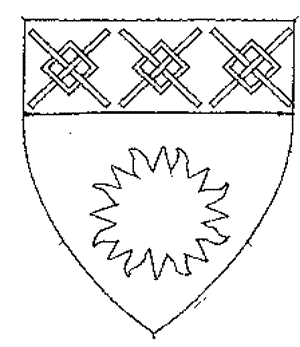 |
Argent, a sun sable and on a chief azure three frets argent
The submitter will not accept major changes, cares most about sound (KAHT-leen), desires a female name, does not want her name changed to be authentic, and will accept a holding name.
Caitlin can be found in Patrick Woulfe, Sloinnte Gaedheal is Gall: Irish Names and Surnames, page 208. Woulfe states that Caitlín is a variant of Caitrín and was the name of the virgin and martyr of Alexandria. He goes on to say that the name was brought to Europe by the Crusaders. E.G. Withycombe, Oxford Dictionary of Christian Names (s.n. Katharine, page 186-187) provides undated citations of the Irish form Caitlin being often used in England. She further states that Caitlin is decended from the Middle English name Catlin. Donnchadh Ó Corrain and Fidelma Maguire, Irish Names (page 45) state that the Irish forms Caitíona and Caitilín (also Caitlín) are derived from the Old French names Caterine and Cateline.
Dálaig can be found in Donnchadh Ó Corrain and Fidelma Maguire, Irish Names (s.n. Ragnall, page 154) dating Ragnall Ua Dalaig to 1161. Mari Elspeth nic Bryan, Index of Names in Irish Annals: Muirchertach/Muircheartach, dates Muircertach Ua Dálaigh to 1459 and Muirceartach mac Con Connacht Ui Dhálaigh to 1466. Copies of the annals documentation are included.
|
| 4. Chinua Temur |
Wealdsmere |
Badge, New |
 |
(Fieldless) Two arrow inverted in saltire, within a bordure gules
The submitter's name appears on the July 2004 An Tir Letter of Intent.
|
5. Dagmær in hvassa
change from Damaris de Sheldon |
|
Name Change |
|
The submitter will not accept major changes, cares most about language/culture (unspecified), desires a female name, does not want her name changed to be authentic, and will accept a holding name. Her current name was registered in June of 1995.
Dagmær can be found in the 14th century saga Hálfdanar saga Eysteinssonar, available at http://www.snerpa.is/net/forn/half-e.htm. The text lists Dagmær as the wife of Hans. Copies of this documentation were not included.
in hvassa can be found in Geirr Bassi Haraldsson, The Old Norse Name (s.n. inn hvassi page 23). Geirr Bassi states that the epithet means "the sharp or keen." When a masculine epithet is used with a feminine name, it should be feminized according to the rules provided on page 19. For this epithet, the second -n of inn is dropped and the weak masculine ending -i is changed to -a.
|
| 6. Jak M'Kenye |
Aquaterra |
Name and Device, New |
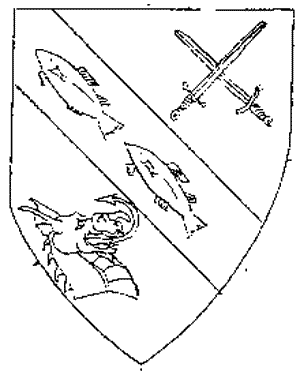 |
Sable on a bend argent two fishes niant gules between in chief, two swords in saltire and in base a dragons head couped contourney argent.
The submitter will not accept major changes, cares most about language/culture (late period Scots), desires a male name, wants his name changed to be authentic for late periods Scots, and will accept a holding name.
Jak is found in George F Black's The Surnames of Scotland (s.n. Jack). Black dates this name to 1453 and 1469.
M'Kenye is found in George F Black's The Surnames of Scotland (s.n. MacKenzie). Black dates this name to 1513.
|
| 7. Katerine Martel |
Adiantum |
Name and Device, New |
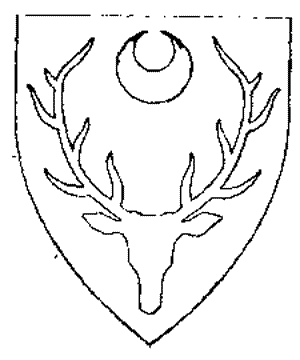 |
Sable, a stag's head cabossed and in chief a crescent argent
The submitter will not accept major changes, cares most about language/culture (unspecified), desires a female name, wants her name to be changed to be authentic for unspecified, and will accept a holding name.
Katherine can be found in E.G. Withycombe, Oxford Dictionary of Christian Names (Katharine). Withycombe states that this name was brought to England by early Crusaders. She goes on to state that the Old French forms of the name were Caterine and Cateline and the Middle English forms were Katerine, Kateline, and Catline. Withycombe dates this spelling of the name to the 15th century.
Martel can be found in P.H. Reaney and R. M. Wilson, A Dictionary of English Surnames (s.n. Martel). Reaney and Wilson date Martel to 1086 and 1148. This name can also be found in Charles Bardsley, A Dictionary of English and Welsh Surnames. Bardsley dates this spelling to 1273, and dates Martell to 1379. Copies of correspondence from Signora Francessa Testarossa dei Martini providing this information were included.
|
| 8. Katerine Martel |
Adiantum |
Badge, New |
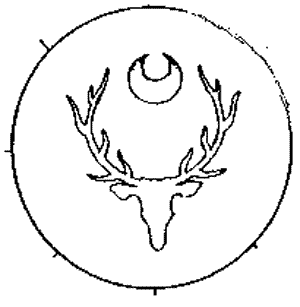 |
Argent, a stag's head cabossed and in chief a crescent sable.
|
| 9. Katerine Martel |
Adiantum |
Badge, New |
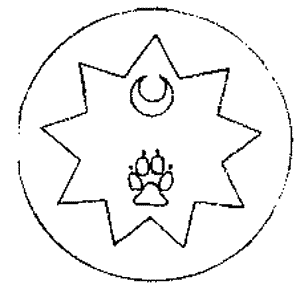 |
(Fieldless) On a mullet of nine points a crescent azure and a paw print vert.
No blazon was provided with this form, Lions Blood has blazoned this device from the emblazon. The fieldless badge box was not checked; however, this could be fielded armory with an indented bordure as both the field and bordure would then have been argent.
|
| 10. Lora Lin of Dinas Bran |
Hartwood |
Name and Device, New |
 |
Argent, on a Laurel tree eradicated proper, a recorder in bend sinister argent all within a bordure sable.
The submitter will accept any changes, cares most about meaning (Lora Lin of the Castle of the Crow), desires a female name, wants her name changed to be authentic for Welsh 12th to 14th century and will accept a holding name.
Lora can be found in Aelfwyn aet Gyrum (Jodi McMaster) Feminine Given names from Kent, 1302-1363. This article dates the given name to 1349-1350. Copies of this documentation were provided.
Lin can be found in George F. Black, The Surnames of Scotland. (s.n. Lynne). This form is dated as a surname to 1468 where Patrick Lin or de Lyn was burgess of Edinburgh.
No documentation was provided for Dinas Bran.
|
| 11. Muriel Buchanan |
Aquaterra |
Name and Device, New |
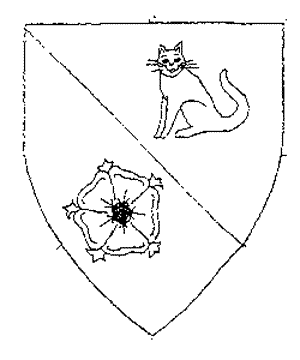 |
Per bend argent and azure, in bend sinister a cat sejant affronte sable and a rose argent slipped vert seeded sable
The submitter will not accept major changes, cares most about language/culture (Scots), desires a female name, wants her name changed to be authentic for Scots, and will accept a holding name.
Muriel is found in George F. Black, The Surnames of Scotland. (s.n. Achenburg) and dated to 1238.
Buchanan is found in George F. Black, The Surnames of Scotland. (s.n. Buchanan) and dated to 1270.
|
| 12. Skapti Þorinsson |
Madrone |
Device, New |
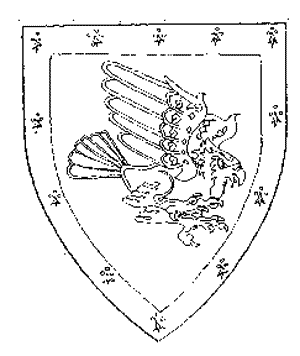 |
Sable, an eagle striking contourny Or and a bordure erminois
The submitter's name was registered in March of 2003.
|
| 13. Skapti Þorinsson |
Madrone |
Badge, New |
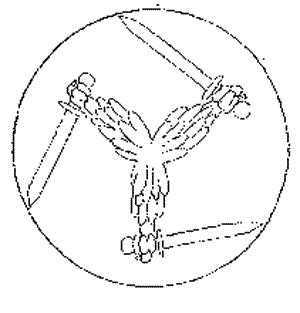 |
(Fieldless) Three eagles jambes conjoined in triskelion Or, each claw maintaining a sword sable.
The submitter's name was registered in March of 2003.
|
| 14. Stephen of Hunmanby |
|
Name and Device, New |
 |
Gules, a cross fleury within an annulet Or
The submitter will not accept major changes, cares most about sound and language/culture, desires a male name, wants his name to be changed to be authentic for 12th to 13th century England, and will accept a holding name.
Stephen can be found in E.G. Withycombe, Oxford Dictionary of Christian Names. (s.n. Stephen ). The name is also found in George F. Black, The Surnames of Scotland. (s.n. Stephen). Support for the use of the "ph" can be found in Burrow and Turville-Petre, A Book of Middle English (The Peterborough Chronicle, page 76), appearing twice in the spelling Stephne. Copies of this documentation were provided.
Hunmanby is a village and manor in Yorkshire. This village can be dated to 1138 in Lucy Owston, Hunmanby East Yorkshire: A Story of Ten Centuries. Copies of this documentation were provided.
|
| 15. Stephen of Hunmanby |
|
Badge, New |
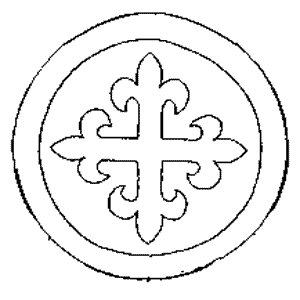 |
Gules, a cross fleury and a bordure Or
|
| 16. Tomas Alvarez |
Borealis |
Device, Resubmission |
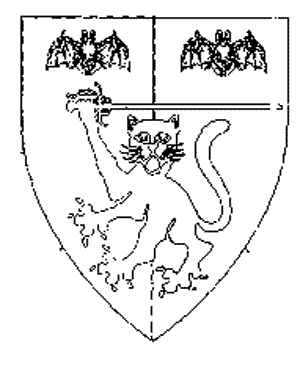 |
Per pale gules and sable, a domestic cat guardant rampant or, maintaining a rapier argent and in chief 2 reremice or
The submitter's name was registered in March 2004.The submitter's previous device, Per pale gules and sable, domestic cat guardant rampant Or, maintaining a rapier argent, was returned for multiple conflicts against cats rampant. The rapier was not adjudged to carry sufficient weight to clear these conflicts. The addition of the reremice addresses this issue.
|
| 17. Tristan Fiddler |
Wyewood |
Name and Device, New |
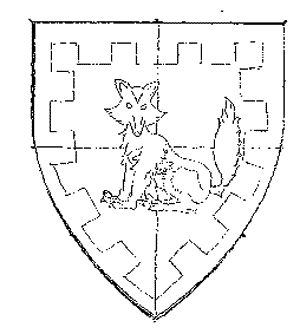 |
Quarterly gules and argent, a fox sejant guardent sable and a bordure embattled counterchanged.
The submitter will accept any changes, cares most about language/culture (unspecified), desires a male name, does not want his name changed to be authentic, and will accept a holding name.
Tristan can be found in E.G. Withycombe, Oxford Dictionary of Christian Names. (s.n. Tristam). Withycombe states that the usual form in England was Tristam and dates this form to 1189. She also states that Tristan was found as a surname in France by the end of the 12th century.
Fiddler can be found in P.H. Reaney and R. M. Wilson, A Dictionary of English Surnames (s.n. Fidler). Reaney and Wilson date le ffithelere to 1285 and Fydeler to 1379.
|
| 18. Wilhelm der Krieger |
|
Device, Change |
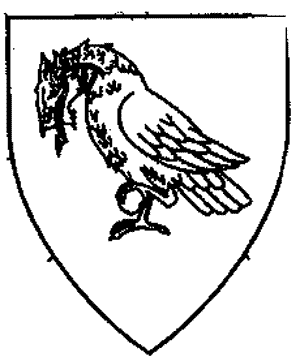 |
Or, a dragon-headed raven close azure holding a ball gules in sinister claw.
The submitter's name was registered in October 1983.The submitter would like to retain his old device, Vert, a bend between two foxes heads erased argent, as a badge.
|
| 19. Wilhelm der Krieger |
|
Badge, New |
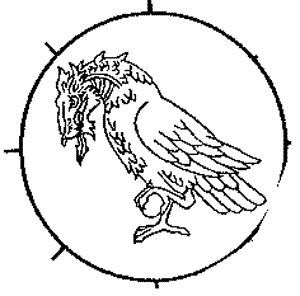 |
(Fieldless) A dragon-headed raven close sable holding a ball gules in sinister claw
The submitter's name was registered in October 1983.
|
| 20. Wyll Hauk |
|
Badge, New |
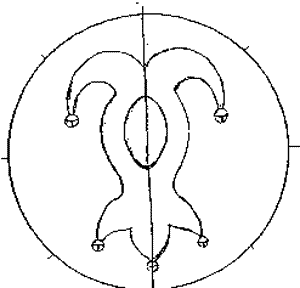 |
Per pale azure and vert, a jester's head per pale argent and OR bells counterchanged
The submitter's name was registered in October 1983. The face area of this hood is sable.
|
In service to the An Tir College of Heralds,





 Ermynee. Serra fet blanc e bien savoree de bon poudre de gyngyvre, e de quibebes e de clous, e cele viaunde deit estre partie ou vert desirree.
Ermynee. Serra fet blanc e bien savoree de bon poudre de gyngyvre, e de quibebes e de clous, e cele viaunde deit estre partie ou vert desirree.
 Vert desirree. Let d'alemaundes, flur de rys, braoun de chapoun, vyn vermail, sucre, percil; le colour serra vert.
Vert desirree. Let d'alemaundes, flur de rys, braoun de chapoun, vyn vermail, sucre, percil; le colour serra vert.




















